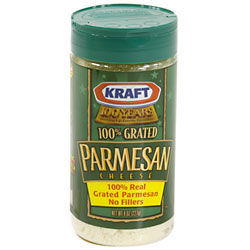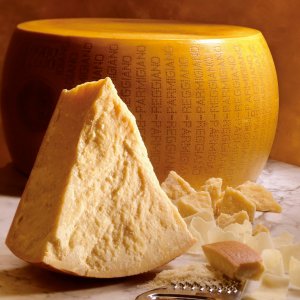Last night I was making meatballs, and was forced to break a cardinal rule by using Kraft parmesan cheese – the powdery stuff with a sawdust-like consistency – in place of the Parmigiano-Reggiano I normally use. I hadn’t realized we were out of the “good stuff” until I started cooking, and at that point there was no turning back. Desperate times called for desperate measures. “How much of a difference can it really make?” I asked myself.
The sad truth is, a lot.
 The Italian wedding soup I was making turned out fine, but the meatballs were definitely missing something. I tried to compensate for the lack of real cheese by adding garlic salt, minced onion, and parsley, but it was all for naught. They were blander than usual. At that point, I began to wonder what – exactly – is in that can of Kraft parmesan, a childhood staple growing up that has long since fallen out of favor, except to shake onto slices of pizza. The can does say it’s made with “100% real grated parmesan, no fillers.” So I did some digging, and it turns out our definition of parmesan differs from Europe’s definition of parmesan.
The Italian wedding soup I was making turned out fine, but the meatballs were definitely missing something. I tried to compensate for the lack of real cheese by adding garlic salt, minced onion, and parsley, but it was all for naught. They were blander than usual. At that point, I began to wonder what – exactly – is in that can of Kraft parmesan, a childhood staple growing up that has long since fallen out of favor, except to shake onto slices of pizza. The can does say it’s made with “100% real grated parmesan, no fillers.” So I did some digging, and it turns out our definition of parmesan differs from Europe’s definition of parmesan.
The only true parmesan is Parmigiano-Reggiano, a hard cow’s milk cheese produced in the Parma, Reggio-Emilia, Modena, and Bologna regions of Italy. Under European law, only cheese produced in this region can be called Parmigiano-Reggiano. There’s a very exacting process of producing this cheese (cows must be fed grass or hay only; the cheese is made in heated copper kettles, rested in molds, soaked in brine, then allowed to age a minimum of twelve months; it contains unpasteurized milk, salt, and rennet only; etc.). The cheese has a long history, and was originally created during the Middle Ages in Bibbiano, Italy. While the name is trademarked in Europe, no such rules apply outside of that continent. In the U.S. and other countries, commercially produced imitation cheeses can be sold under the generic name “parmesan.”
And that’s where our friend in the green can comes in.
Kraft first introduced the product in 1945. It gained widespread popularity as a topping for spaghetti and other pastas. There was always a can in the fridge growing up. My dad called it “stinky cheese.” We used it liberally. Though what exactly we were using is open to debate. Kraft developed a process in which the cheese is aged a mere six months, rather than the year or two required of true parmesan. This was nothing more than a business decision for Kraft: less time on the shelf opens up costly plant space and cuts down on production costs. Both Italians and smaller U.S. cheese makers scoff at the idea. Paul Bauer of Wisconsin’s Antigo Cheese Co. says cheese cured in six months “is not parmesan. Parmesan is cheese that develops its flavor over time.”
Be that as it may, the FDA stands behind Kraft’s shorter-production “parmesan” cheese. Let’s not even get into the fact that it contains ingredients such as “cellulose powder” and “potassium sorbate.”
All I know is, my meatballs did not taste the same, and based on everything I’ve read, I can blame it on the fake cheese.







I had the same issue last week! I used, despite my better judgment, Digiorno’s shredded cheese (dried cellulose included) in a pasta dish since I had no “real” cheese. It clumped into balls, like it was literally taking a stance against being added to my dish, rather than melting and had zero flavor. Never again! Ha. 🙂
LikeLike
Mmm…dried cellulose. My mouth is watering already!
You know, the sad thing is, we since ran out of the green can of cheese…and bought another one! There are certain things in which it’s acceptable to use this on (e.g. pizza slices and popcorn). Otherwise, forget it.
LikeLike
Powdered cellulose is used to keep the cheese from clumping. It is, a naturally occurring substance that resists moisture, which is why your cheese seemed to avoid incorporation into your dish. Lets not get all weird and claim this is an unnatural substance, as it is 100% natural. It sure is a funny thing to add to Cheese however, since most people want their meals to blend together, not separate into individual ingredient pockets.
LikeLike
I was never a fan of Parm cheese. Like your Dad, it was stinky and reminded me of throw-up. Sorry, but it did!!
The good ol’ USofA gets away with a lot of stuff. Like calling sparkling wine Champagne when it’s not. I got in a huge argument with a guy over that and he still thought he was right. The same with cheese. There is a reason cheese, like Parmigiano-Reggiano, is a true Parmigiano.
Honestly!
LikeLike
“Like your Dad, it was stinky and reminded me of throw-up.”
Hey! My dad is NOT stinky!!
LikeLike
The only difference between sparkling wine and champagne is the name.
LikeLike
And about $20 a bottle.
LikeLike
When I was a kid, it was the only choice. It did not have cellulose. But it was incredibly sharp and tangy like no other Parmesan, so much so that I still can’t understand how it can be so weird.
LikeLiked by 1 person